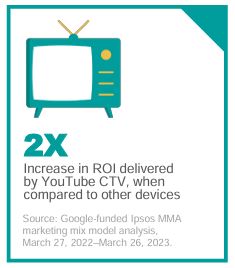- Company / Subway
- Industry / Restaurant
- Service / Marketing Mix Modeling
Just a few years ago, marketing mix modeling seemed to be fading in importance. Many considered it a relic of predigital times, with a limited ability to generate actionable insights and recommendations. But recent innovations have made marketing mix models (MMMs) far more nimble. When taken together with the inherent privacy durability of MMMs and their ability to measure all marketing spend on a level playing field, these innovations suggest marketing mix models have a bright future in our industry.
Learnings
At Subway®, MMMs are integral to its cross-media measurement strategy and help the company evaluate the effectiveness of its marketing and media investments. In an effort to further hone its approach, Subway enlisted Ipsos MMA and Google to help navigate an increasingly complex consumer landscape and allocate spend accordingly.1 Here are some of the learnings:
1. Develop More Granular Insights
With the fragmentation of digital advertising across media and ad formats, devices, market areas, and bid strategies, marketers must be cautious not to oversimplify their measurement frameworks. At Subway, it had recommitted to capturing granular insights in order to figure out which channels and ad types represent the smartest investment and to make more informed decisions. Thankfully, digging into these details is easier than ever.
In partnership with Google and Ipsos MMA, Subway has been able to isolate the impact of various types of campaign-level marketing data and integrate those insights into our model. For example, we learned that layering bumper ads on top of TrueView ads drove 2X higher ROI than running TrueView alone, and that sequencing video ads proved 20% more effective than YouTube’s average performance metrics. These measurement strategies and capabilities, once unthinkable in marketing mix modeling, have helped Subway see both the forest and the trees when allocating marketing investments.
2. Consider Long Term Effects
MMMs typically account for the effects of advertising months after initial exposure. But what about measuring its compound effect over a period of years? Many marketers will prioritize quick wins and short-term gains when money is tight, but it’s critical not to lose sight of your brand’s long-term health. While collaborating with Google and Ipsos MMA, we wanted to examine the impact of advertising over a lengthy time period. So we ran a long-term effects model that applied key brand health metrics, such as unaided awareness, consideration, and familiarity. The results were clear: Investing in digital is an effective way to increase brand health metrics. Due to our strategic adjustments, Subway’s return on ad spend for online video has increased 1.8X since 2021.3

3. Lean Into Multiple Data Sources
Data is essential for driving meaningful organizational change. We use multiple data points to make informed decisions about our marketing strategy and achieve better results for our franchisees. For example, we used Google’s Reach Planner to understand the reach and frequency dynamics of our advertising on YouTube and linear TV. Reach Planner revealed that we were reaching our target audience 3.5X more per month on TV relative to YouTube.4
This insight into relative frequency played a pivotal role in shaping the qualitative metrics that guided our interpretation of our MMM results. Then we uncovered another astonishing insight: YouTube on connected TV (CTV) was 2X more effective than other devices.5 These complementary data points gave us the confidence to increase Subway’s YouTube, streaming, and overall digital presence by more than 50%. The business results spoke for themselves. By leaning into these learnings, our business saw 10 consecutive quarters of sales growth.
While we’ll always value TV’s role in our media plan, the data we uncovered helped us better understand its contribution relative to other channels. readiness. Of course, implementing all of the above into your marketing strategy is easier said than done. Feeding nuanced insights into your MMM and acting on its output may require significant organizational changes at your company. This is exactly the challenge we faced at Subway, and we tackled it one step at a time.
First, we aligned stakeholders on KPIs and our measurement strategy, ensuring everyone was on the same page for consistency and efficiency. While this may seem straightforward, achieving cross-functional alignment can be daunting.
For instance, while some decision-makers evaluate operating costs and efficiencies across the marketing organization, others must prove the impact of their budgets. If they want to make the best decisions for their business, both must align on their objectives and believe in measurement and data. Achieving this alignment means ensuring stakeholders are comfortable with how a marketing mix model works and overcoming any fears they may have. It’s important to explain what MMMs can and can’t do for your team.
We also realized that we needed a more holistic approach to measurement. In the past, traditional media and digital media were often siloed, with different teams responsible for measuring and analyzing each. After breaking down the silos, we better understood how these channels complement each other. While having a single team evaluate every type of media may seem incredibly complicated, in reality it’s simple. No matter the medium, we see what works the best, maximizing ROI, traffic, and revenue with the budget we have.
At Subway, we’re always trying to answer one question: How do we take our franchisee’s dollars and invest them in media that will drive money back to the franchisees? Rethinking our MMM strategy has helped us get closer to that goal.
As a brand with 60 years of experience, we know that consumer trends and consumption habits are constantly evolving, especially among younger generations. Going forward, we believe that MMMs will be a critical tool in helping brands to understand the micro and macro shifts in marketing behaviors that impact performance on any time horizon.
